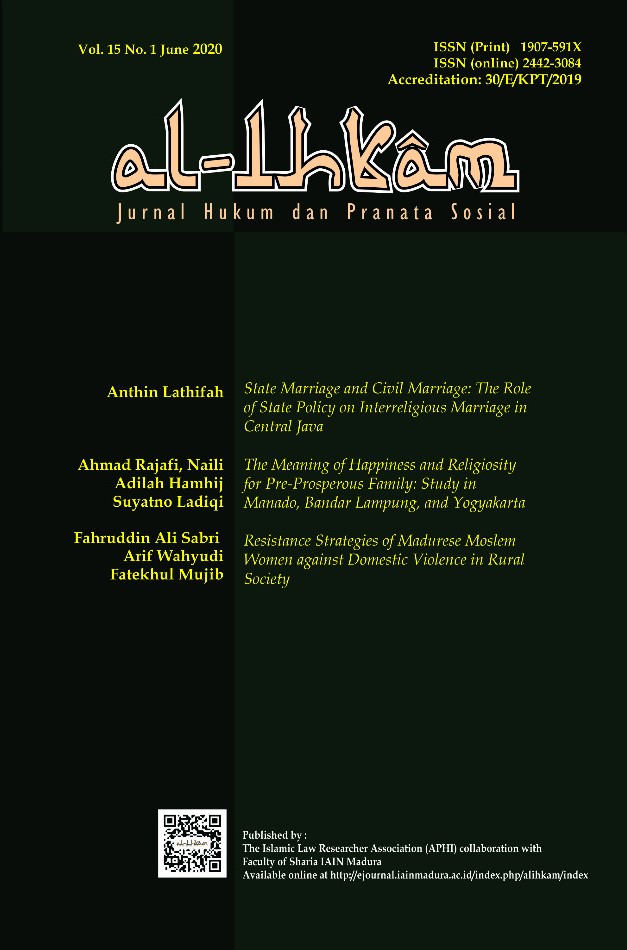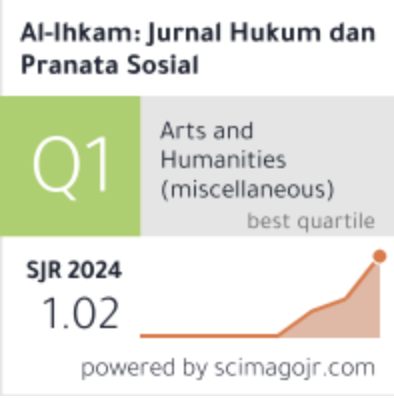Resistance Strategies of Madurese Moslem Women against Domestic Violence in Rural Society
 Abstract views: 736
,
Abstract views: 736
,
 PDF downloads: 549
PDF downloads: 549
Abstract
Although regarded as weak, helpless and vulnerable for violence, some rural Madurese women are no longer silent and passive in coping with domestic violence they experience. This study aims to identify the survivors’ experiences and choices they made as resistance strategies to reduce or end the violence. The focus was on whether the choices fit with sharia teaching. The study uses empirical legal research and anthropological theory of law and fiqh approach to analyze data. It finds that women who try to take a dispute resolution process show their active attitude and courage to voice injustice, discomfort or disagreement in their domestic life. Some of their strategies fit with shariah teaching while others do not so. However anthropologically, their choice to stop the violence is for the sake of maintaining their marital relation. In the legal sub-culture, they have well considered potential profits and losses as well as the needs or interests they want to get.
Downloads
References
Abdullah, Amin. Mencari Islam: Studi Islam Dengan Berbagai Pendekatan. Yogyakarta: Tiara Wacana, 2000.
Abraham, Margaret. Speaking the unspeakable: Marital violence among South Asian immigrants in the United States. New Brunswick, New Jersey and London: Rutgers University Press, 2000.
Barrett, Jerome T, dan Joseph Barrett. A history of alternative dispute resolution: The story of a political, social, and cultural movement. San Francisco: John Wiley & Sons, 2004.
Bukhârî, Muhammad bin Ismâ’il Abû Abdullah al-. al-Ṣahîh al-Bukhârî. al-Qâhirah: Dâr al-Sya’b, 1987.
Cresswel, Jhon W. “Penelitian Kualitatif dan Desain Riset (edisi bahasa Indonesia).” Yogyakarta: Pustaka Pelajar, 2015.
Davis, Rachel, Lisa Fujie Parks, dan Cohen. Sexual violence and the spectrum of prevention: towards a community solution. Enola PA: National Sexual Violence Resource Center, 2006.
Dillon, Gina, Rafat Hussain, Deborah Loxton, dan Saifur Rahman. “Mental and physical health and intimate partner violence against women: A review of the literature.” International journal of family medicine 2013 (2013).
Friedman, Lawrence M. The Legal System: a Social Science Perspective. New York: Russel Sage Foundation, 1975.
Harway, Michele, dan James M O’Neil. What causes men’s violence against women? London: Sage Publications, 1999.
Hossain, Naomi. “Security and the pathways of women’s empowerment: Findings from a thematic synthesis of the pathways of women’s empowerment research.” IDS Working Papers 2012, no. 406 (2012): 1–48.
Irianto, Sulistyowati. Perempuan di Antara Berbagai Pilihan Hukum. Jakarta: Yayasan Pustaka Obor Indonesia, 2003.
Khaleed, Badriyah. Penyelesaian Hukum KDRT: Penghapusan Kekerasan dalam Rumah Tangga dan Upaya Pemulihannya. Yogyakarta: Pustaka Yustisia, 2015.
Komnas, HAM. “Laporan Tahunan Komnas HAM 2016: Pemenuhan Hak Kelompok Minoritas dan Rentan di Indonesia.” Jakarta: Komnas HAM, 2017.
Kuennen, Tamara L. “Analyzing the impact of coercion on domestic violence victims: How much is too much.” Berkeley J. Gender L. & Just. 22 (2007): 2.
Miles, Matthew B, dan A Michael Huberman. “Analisis Data Kualitatif. Terjemahan Tjetjep Rohendi Rohidi.” Jakarta: Penerbit Universitas Indonesia, 1992.
Moleong, Lexy J. Metodologi penelitian kualitatif. Bandung: Remadja Karya, 1989.
Morgan, Mandy, dan Tony Mattson. “Dignity, diversity, and resistance: A bicultural, community-led approach to transforming social responses to domestic violence in Aotearoa New Zealand.” Australian Community Psychologist 29, no. 2 (2018).
Muslim bin al-Ḥajjâj al-Naysabûrî, Abû al-Husayn. Al-Jâmi’ al-Ṣahîh Muslim. Bayrût: Dâr Ihyâ‘ al-Turâth al-‘Arabî, tt.
Nader, Laura, dan Harry F Todd. The disputing process: Law in ten societies. New York: Columbia University Press, 1978.
Nifosi-Sutton, Ingrid. The protection of vulnerable groups under international human rights law. New York: Routledge, 2017.
Nurdin, Ali. “Komunikasi Magis Dukun (Studi Fenomenologi Tentang Kompetensi Komunikasi Dukun).” Jurnal ASPIKOM 1, no. 5 (2012): 383–402.
———. Komunikasi Magis Fenomena Dukun di Pedesaan. Yogyakarta: LKiS Pelangi Aksara, 2015.
Perempuan, Komnas. “Korban Bersuara, Data Bicara Sahkan Ruu Penghapusan Kekerasan Seksual Sebagai Wujud Komitmen Negara Catatan Kekerasan Terhadap Perempuan Tahun 2018.” jakarta, 6 Maret 2019.
Rifai, Mien Ahmad. Manusia Madura: Pembawaan, perilaku, etos kerja, penampilan, dan pandangan hidupnya seperti dicitrakan peribahasanya. Yogyakarta: Pilar Media, 2007.
Roberts, Albert R. Handbook of domestic violence intervention strategies: Policies, programs, and legal remedies. New York: Oxford University Press, 2002.
Sadlân, Shâlih bin Ghânim al-. al-Qawâ’id al-Fiqhiyyah al-Kubrâ. al-Riyâdl: Dâr Balinsiyah, 1417.
Scott, James C. Weapons of the Weak: Everyday Forms of Peasant Resistance. New Haven and London: Yale University Press, 1985.
Shapiro, Martin. Courts: a comparative and political analysis. London: University of Chicago Press, 1981.
St Vil, Noelle M, Bushra Sabri, Vania Nwokolo, Kamila A Alexander, dan Jacquelyn C Campbell. “A qualitative study of survival strategies used by low-income black women who experience intimate partner violence.” Social work 62, no. 1 (2017): 63–71.
Strauss, Anselm, dan Juliet Corbin. “Dasar-dasar penelitian kualitatif.” Yogyakarta: Pustaka Pelajar, 2003.
Wiyata, A Latief. Carok; Konflik Kekerasan & Harga Diri Orang Madura. Yogyakarta: LKIS Pelangi Aksara, 2002.
In order to be accepted and published by Al-Ihkam: Jurnal Hukum dan Pranata Sosial, author(s) submitting the article manuscript should complete all the review stages. By submitting the manuscript, the author(s) agreed to the following terms:
- The copyright of received articles shall be assigned to Al-Ihkam: Jurnal Hukum dan Pranata Sosial as the publisher of the journal. The intended copyright includes the right to publish articles in various forms (including reprints). Al-Ihkam: Jurnal Hukum dan Pranata Sosial maintain the publishing rights to the published articles.
- Authors are permitted to disseminate published articles by sharing the link/DOI of the article at Al-Ihkam: Jurnal Hukum dan Pranata Sosial. Authors are allowed to use their articles for any legal purposes deemed necessary without written permission from Al-Ihkam: Jurnal Hukum dan Pranata Sosial with an acknowledgment of initial publication to this journal.
- Users/public use of this website will be licensed to CC-BY-SA.



.png)
_1.png)


_page-00011.jpg)


